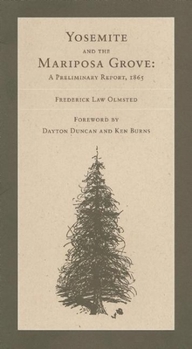The Yosemite Valley and the Mariposa Grove of Big Trees: A Preliminary Report, 1865
Select Format
Select Condition 
Book Overview
When Ken Burns and Dayton Duncan visited Yosemite National Park, they both called out Fredrick Law Olmsted as a major influence and inspiration for their documentary film, The National Parks: America's Best Idea. To celebrate Mr. Olmsted and his contributions to our National Parks, the Yosemite Conservancy, in partnership with Heyday Books, has reprinted "Yosemite and the Mariposa Grove: A Preliminary Report, 1865" with a new foreword by Dayton Duncan and Ken Burns. This seminal book is a must read for anyone interested in the National Parks and our public lands. The first eloquent expression of the need for conservation in 1865 is found in this remarkable and prescient report by Frederick Law Olmsted. No statement since has been so cogent or powerful. Pristine natural landscapes, Olmsted observed, provide people with "refreshing rest and re-invigoration." They are good - perhaps essential - for the soul. Which is why, he noted, that from time immemorial they have most often become the exclusive domain of any society's most privileged classes, "a monopoly, in a very peculiar manner, of a very few, very rich people." Olmsted believed a great democracy had a greater obligation: "to provide means of protection for all its citizens in the pursuit of happiness." That meant, he argued, that "the establishment by government of great public grounds for the free enjoyment of the people . . . is thus justified and enforced as a political duty." Olmsted gave additional reasons for creating public parks, including that they are undeniably good for the local, state, and national economy because of the tourist business they engender. His report also included practical advice about building roads and shelters, as well as instituting regulations to zealously protect the "dignity of the scenery." All of his points are as pertinent today as they were when he first read them to his fellow Yosemite commissioners nearly 150 years ago. But in deliberately borrowing from our nation's founding document, which proclaims that the "pursuit of happiness" is among the inalienable rights of every human being, and in attaching that notion to why Yosemite (or any other future park) should not be allowed to become "a rich man's park," Olmsted infused the national park idea with its most enduring principle."
Format:Paperback
Language:English
ISBN:0939666693
ISBN13:9780939666690
Release Date:August 1995
Publisher:Yosemite Conservancy
Length:44 Pages
Weight:0.25 lbs.
Dimensions:0.2" x 5.0" x 9.0"
Customer Reviews
1 rating
Olmsted's Vision for Yosemite
Published by Thriftbooks.com User , 15 years ago
Most people associate John Muir with the foundation of Yosemite National Park. Frederick Law Olmsted, to the extent he is remembered at all, is thought of as the founder of America's urban parks, most notably Central Park in New York. Yet long before Muir traveled to the Yosemite Valley, Olmsted was there. He had moved to California to manage the Mariposa Estate mining district during the Civil War but he quickly discovered the quiet beauty of Yosemite. Determined to help preserve this unique treasure, he was named chairman of the first state Yosemite Commission charged with managing the "Yosemite Grant." (In 1864, Yosemite was not a national park per se, but the government granted it to California to manage for recreation and future enjoyment.) This report was delivered to the rest of the commissioners in 1865 as they camped in the Valley. At the time, Yosemite was just a small reserve consisting of the Valley proper and 4 square miles of the Mariposa grove, but Olmsted offered a grander vision than the limited grant of the federal government. This "preliminary report" is rightly seen by historians as foreshadowing the role of the whole National Park Service. In addition to requesting what was seen at the time as a huge sum of money for park maintenance, Olmsted hoped to employ scientists to study the broader Yosemite ecosystem. He also recognized the scenic value of the high Sierra and Tuolumne Meadows and sought protection for these areas as well. In an oft quoted passage, he argued that the goal of park managers should be "the preservation and maintenance as exactly as possible of the natural scenery; the restriction, that is to say, within the narrowest limits consistent with the necessary accomodation of visitors, of all constructions markedly inharmonious with the scenery..." Many see in this phrase a vision entirely consistent with the modern environmentalist movement. But Olmsted was not a modern environmentalist or even park manager. He was, if anything, more farsighted than those who claim his legacy today. In the first instance, Olmsted recognized that preservation of natural resources for the purpose of recreation and personal renewal is something only wealthy societies can afford. One cannot imagine him siding with the contemporary left in criticizing the wealth capitalism generates. It was this very wealth, he correctly notes, that allows for an appreciation of Yosemite as the scenic beauty it is. But Olmsted differed even more fundamentally from the modern environmentalist movement. The latter seeks to limit access to the wilderness to better preserve it. But Olmsted, living in the period when America's most bloody war was fought in part to decide who was entitled to citizenship, had a much more egalitarian vision. Wealthy elites in the past, he noted, had always found a way to escape to their private preserves. But in America, the parks should be open to everyone. Towards that end, he advocated building modern





